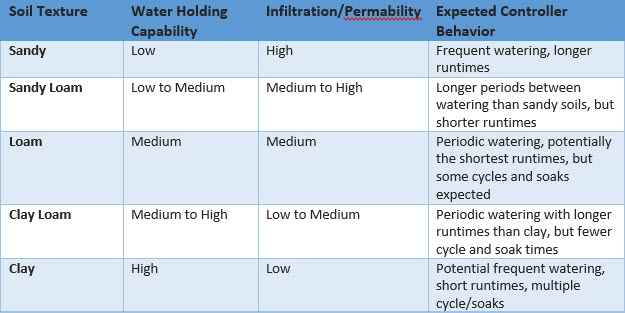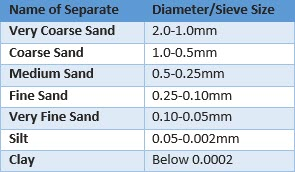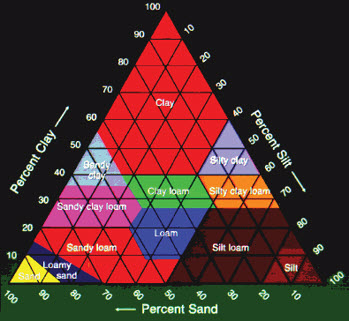Identifying and understanding existing site soil is an important factor in meeting plant needs. Soil type is one of several variables that will ensure accurate application of water to foster plant health.
It is important to know what the soil type that you are irrigating in. Properly spaced sprinkler heads will discharge water in a measureable value called “precipitation rate” or the amount of water applied in inches per hour. Different sprinkler types have different precipitation rates that may not always be matched to the soil’s infiltration rate or ability to absorb water. Applying water too fast in a sandy soil could drive the water past the root zone where supplemental irrigation is ineffective. The same principle of applying water too fast in a clay soil with a slow infiltration rate may cause irrigation run-off and waste water.
Soil type is determined by the percentages of soil particles that can pass through various sieve sizes.The percentage of particle sizes can impact soil-plant interactions particularly water holding/retention and infiltration/percolation properties. The following table identifies general guidelines of soil texture, water holding capability, permeability and expected controller behavior.
Other physical properties such as mineral content can also determine a plant’s ability to absorb and hold onto existing soil nutrients or additives from supplemental fertilization. Smaller particle sized soils such as clay, tend to absorb water slower than larger particle sizes such as sand. Soil absorption rates will also impact the number of irrigation cycles and soak times between cycles and prevent run-off or water traveling below the root zone where plant intake is ineffective.
The three major categories of soil texture represent different particle shapes. For example, a sand particle tends to be quite angular and has a fairly large particle size compared to a clay soil particle. The shape and electrical charge of a sand soil particle also results in a porous soil and tends to be fast draining that can quickly pass water and nutrients below root zones where they cannot be absorbed. Sandy soils also do not commonly compact as well as smaller more tightly shaped soil particles such as loam or clay. Clay soil typically represents the smallest particle size and also has the strongest electrical charge. Clay soil holds the soil particles tightly together slowing infiltration rates and water availability to plants.

Determining Soil Type
There are a number of field methods that can be used to quickly place your soil type in one of the three major soil texture classifications. The enclosed web link provides a step by step method of quickly determining soil texture in the field.
http://soil. gsfc.nasa.gov/tbf/tbfguide.htm
For greater accuracy, detailed information and less reliance on in-field techniques, collect a large coffee can sample and contact your local Farm Advisor’s office for the nearest soil lab. The table below depicts the recognized soil size separates used to classify a particular soil.

Below is a soil texture classification chart depicting soil particle size percentages and soil texture classifications.





